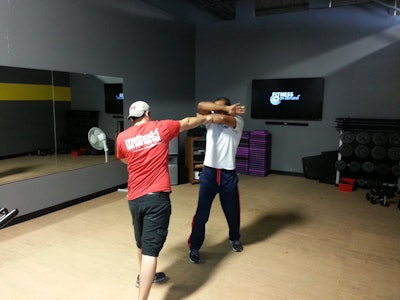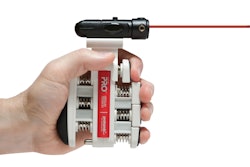 Photo: Tony Pearson
Photo: Tony Pearson
I've seen far too many videos and real-life situations in which police and correctional officers are punched in the face or violently assaulted in the line of duty while trying to detain or subdue highly aggressive individuals. You may suffer severe facial injuries, a knockout, or concussion if you're caught off guard, don't keep a proper distance from your assailant, or use ineffective hand positioning or "cover-up."
Any one of us at any time could find ourselves in a compromising position. Even officers with some traditional boxing or self-defense backgrounds know that attacks of this nature will obviously be painful, and could be fight enders. As with all self-defense techniques, the more often you do it, the more effective it will be when it is needed. For this reason, we must continue to train hard daily and fight like our life depends on it, because it does.
The simple, but effective, hand position explained in this article is derived from a basic Taekwondo maneuver. I've also seen boxers like Joe Frazier and George Forman use this "cover-up" very effectively as cover followed by a left hook. This technique will be a great addition to all other "cover-ups" you already have in your arsenal.
Body and Hand Posture
All offensive and defensive hand and foot techniques start with a good, strong base, or stance. You must consider feet position—being able to bob and weave, move left, right, backward, and forward quickly as well as keeping one's balance upon impact. This is the "fighting stance." Shooting instructors refer to it as a modified isosceles, Weaver, or tactical stance. I will take for granted that we are all quite familiar with the meaning "fighting stance."
Within this position, some people prefer to keep their back foot heel slightly off the ground. Others are comfortable standing flat-footed. Either way, you need to be able to push forward, if necessary, and react, regardless of the direction the threat is coming from. Keep 60% of your weight on your back leg so you will be able to use stop-kick or jamming techniques and front foot kicking.
When confronting a belligerent individual or a group, start with a non-offensive stance and hand position. Whether using both hands extended or one hand extended, keep your dominant hand ready to reach for your firearm if need be. The extension of one or both hands in itself can be used as a defensive means against attacks. Hands are also used to judge and keep a safe distance from your adversary.
As police officers, we tend to give suspects orders to turn around and place their hands behind their backs while we are reaching for our cuffs with one hand and reaching for their hands with our other hand. But this leaves you open to being sucker punched or grabbed because you are so close to the subject.
For this reason, I strongly prefer to approach all suspects with a non-offensive hand position while giving them orders. I then allow them time to comply by turning away from me and placing their hands behind their backs before I reach for my cuffs. With your hands and arms extended (using a non-offensive stance) you have more room to move, react, or block. It is not recommended that you assume an obvious ready or an aggressive "fighting stance" with clenched fist. Instead, extend your arms and fingers with hands next to each other in front of you, palms forward and fingers apart, and assume a non-defensive stance.
There should be no tension in your entire body. Deep, focused breathing is essential to relieving tension, even amid the chaos of such a situation. Keep outward appearances calm and non-threatening; you never want to further escalate any situation unless necessary.
Cover-Up and Rhythm
If the suspect chooses to strike you in the head, quickly shift both of your arms and hands from the non-offensive position into "cover-up position" to protect your head. This alternative cover-up consists of placing both arms on top of each other in front of your face, forearms forward and palms facing out on either side.
From this posture, after an appropriate "cover-up" has been executed, push forward using the momentum from your back foot and begin attacking using your elbows, fists, and hand strikes to regain the upper hand. To execute a knife-hand strike to the neck, flatten out your hand and hit the suspect's neck with the side of your hand. To execute a back-fist, hit the suspect's hands with the back of your fist and knuckles. For a hammer-fist, swing your clenched fist downward to hit the suspect's nose or other body part with the padded part of your fist. Eye gouging may also be appropriate if it is the surest way to stop the suspect's attack on you.
When you are on the offense of a skirmish, rhythm becomes most important. There are no one-punch solutions either, just cover-up solutions. Focus on developing rhythmic combinations. For example, cover, back-fist, elbow, eyes, subdue. Or cover, cover, knife-hand, back-fist, hammer-fist, restrain. Next, try cover, move, hammer-fist, trip-up, restrain. During your training, while practicing transitioning from cover-up into strikes, be creative. Mix your attacks up and use different angles. Become strong and proficient performing the techniques with both hands.
Use your body's natural power generators when executing hand techniques from a stationary or moving position. There are three anatomical power generators that will allow you to maximize your striking power: hips, shoulders, and feet. None of the above hand strikes should lock upon impact because that would have a pushing effect and rob you of critical contact power. A good strike should always snap or crack fast and hard when it makes contact with its intended target, and don't forget to put your hips into it.
Kick Jamming, Body Cover, and Front Foot Kicks
From the "non-offensive stance" and "cover-up," the next step will be to protect your body and stop your opponent's kicks while delivering hard offensive kicks of your own. Let's first begin with stopping kicks, or jamming. This process starts from your "non-offensive stance" using your front leg extended and the full flat or side of the front foot. It's essentially a fast, low side kick delivered to your opponent's incoming leg, foot, shin, thigh, or ankle, preventing him or her from launching a kicking attack or stepping in attempting to rush you.
Balance is always important; it becomes even more necessary when you are standing on one leg using jamming techniques and throwing kicks. As was mentioned earlier regarding weight distribution with the "fighting stance," keep 60% of your weight on your back leg in order to lift your front leg quickly for kicking and moving laterally.
As police officers we are generally taught to keep our eyes on people's hands. This works well during traffic stops while that person is sitting, but in a combat standing situation I am recommending that you watch your opponent's eyes. This way you can see his or her whole body, from head to toe. This can help you overcome some fighters' tricks. If a person is adept at kicking he will use his hands as a distraction. Alternatively, if a person is adept at fighting with her hands she will use her feet as a distraction. If you can see the person's whole body in your peripheral vision, you won't be fooled by these tricks.
Jamming, or disrupting an attack with a move of your own, revolves around movement and distance. If your opponent moves toward you in any way, kick low using a side or front kick aiming at the aforementioned targets (shin or thigh). Always "cover" and follow up with strikes, then restraining techniques. As law enforcement officers we never want to get in a boxing match or a Kung-Fu demonstration during the apprehension of a person. I also realize that some officers are in better shape than others, so your attention should be on not getting hit, keeping that person off you, and securing the individual as quickly as possible.
You must practice jamming and front foot kicking quite often to become adept at it. Also realize that with enough reps it will become second nature; this will not require a lifetime of training. Start from your "non-offensive stance," shift your weight 60% to your back leg, lean back slightly, lift your front foot off the ground about 12 inches, bend your knee, slightly kick, then return your foot to the ground maintaining a good solid, grounded stance. Make sure your balance is strong, and when practicing use both sidekicks and front kicks starting from the same "non-offensive stance."
I suggest doing 10 to 25 reps with both left and right leg to practice. Use a wall, training partner, or full-size standing bag in order to gauge if your opponent is within jamming distance. Your rear leg should also be slightly bent because it will help increase your balance.
When protecting your body, use that same "cover up" stance and balance 60% of your weight on your back leg. Then lift your front knee as high as possible to create space between yourself and your opponent, preventing significant impact. If you are not yet completely comfortable using this tactic, keep throwing low kicks; this will also be effective in creating distance. Bruce Lee said, "I fear not the man who has practiced 10,000 kicks once but I fear the man who has practiced one kick 10,000 times."
Tony Pearson has run his own martial arts, fitness, and wellness school, and has worked in several Alabama correctional facilities. He now serves as a police officer for the University of Alabama at Birmingham.















